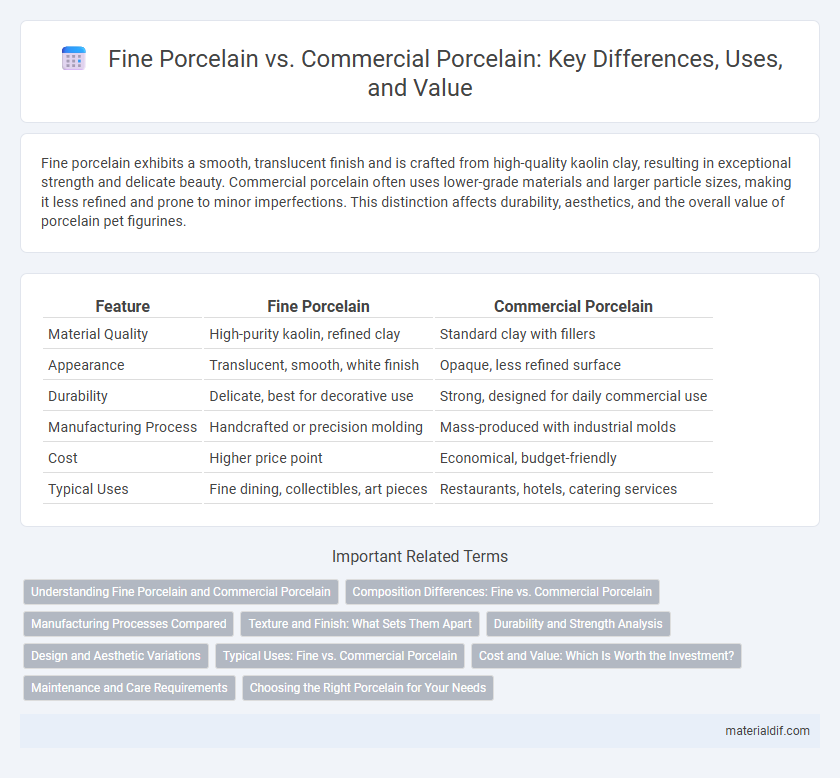Fine porcelain exhibits a smooth, translucent finish and is crafted from high-quality kaolin clay, resulting in exceptional strength and delicate beauty. Commercial porcelain often uses lower-grade materials and larger particle sizes, making it less refined and prone to minor imperfections. This distinction affects durability, aesthetics, and the overall value of porcelain pet figurines.
Table of Comparison
| Feature | Fine Porcelain | Commercial Porcelain |
|---|---|---|
| Material Quality | High-purity kaolin, refined clay | Standard clay with fillers |
| Appearance | Translucent, smooth, white finish | Opaque, less refined surface |
| Durability | Delicate, best for decorative use | Strong, designed for daily commercial use |
| Manufacturing Process | Handcrafted or precision molding | Mass-produced with industrial molds |
| Cost | Higher price point | Economical, budget-friendly |
| Typical Uses | Fine dining, collectibles, art pieces | Restaurants, hotels, catering services |
Understanding Fine Porcelain and Commercial Porcelain
Fine porcelain, characterized by its high kaolin content and refined firing process, exhibits a translucent quality, superior strength, and a smooth, white finish, making it ideal for luxury tableware and collectibles. Commercial porcelain, produced with lower-grade materials and less precise firing methods, offers greater durability and cost-effectiveness but lacks the delicate translucency and refined texture of fine porcelain. Understanding the distinctions in composition, production techniques, and aesthetic qualities helps in choosing the appropriate type of porcelain for specific uses and budgets.
Composition Differences: Fine vs. Commercial Porcelain
Fine porcelain is primarily composed of high-quality kaolin, feldspar, and quartz, resulting in a dense, translucent body with a smooth, refined finish. Commercial porcelain often incorporates lower-grade materials and additives to reduce production costs, leading to a less uniform composition and reduced translucency. The purity and proportion of raw materials in fine porcelain contribute significantly to its superior strength, whiteness, and delicate appearance compared to commercial varieties.
Manufacturing Processes Compared
Fine porcelain is crafted through meticulous processes involving high-quality kaolin, longer firing cycles at temperatures around 1,300degC, and precise glazing techniques that ensure translucency and strength. Commercial porcelain undergoes faster production methods with standard kaolin blends, lower firing temperatures near 1,200degC, and less refined glazing, prioritizing cost-efficiency over durability and aesthetic delicacy. The manufacturing differences directly impact the density, whiteness, and toughness of the final porcelain products.
Texture and Finish: What Sets Them Apart
Fine porcelain features a smooth, delicate texture with a translucent finish that showcases its high-quality craftsmanship, while commercial porcelain tends to have a coarser surface and a more matte or utilitarian finish designed for durability. The refined glazing technique in fine porcelain results in a lustrous sheen and intricate detailing not typically found in commercial-grade pieces. Differences in clay composition and firing temperature also contribute to the superior tactile softness and visual elegance of fine porcelain compared to the rougher texture of commercial porcelain.
Durability and Strength Analysis
Fine porcelain exhibits superior durability and strength due to its higher kaolin content and denser firing process, resulting in a less porous and more resilient material. Commercial porcelain, while still strong, generally contains lower purity clay and undergoes less intensive firing, leading to increased fragility and susceptibility to chipping. The microstructure of fine porcelain enhances its mechanical properties, making it ideal for luxury tableware and delicate art pieces requiring long-term durability.
Design and Aesthetic Variations
Fine porcelain features intricate hand-painted designs and delicate translucency, highlighting high craftsmanship and artistic detail. Commercial porcelain typically showcases simpler, mass-produced patterns with uniform finishes, prioritizing functionality over elaborate aesthetics. Variations in glaze, texture, and form distinctly separate fine porcelain's elegance from the more practical, accessible commercial versions.
Typical Uses: Fine vs. Commercial Porcelain
Fine porcelain is commonly used in luxury tableware, decorative art pieces, and high-end collectible items due to its delicate translucency and refined craftsmanship. Commercial porcelain is typically utilized for everyday dinnerware, industrial applications, and sanitary ware because of its durability and cost-effectiveness. The distinct properties of fine versus commercial porcelain determine their suitability for either aesthetic, high-value purposes or practical, mass-produced uses.
Cost and Value: Which Is Worth the Investment?
Fine porcelain, crafted from high-quality kaolin clay and fired at ultra-high temperatures, commands a higher price due to its superior translucency, durability, and intricate artistry, making it a valuable investment for collectors and connoisseurs. Commercial porcelain, produced with less refined materials and lower firing standards, offers affordability and practicality but lacks the refined aesthetics and long-term value of fine porcelain. Evaluating cost against durability and artistic quality determines that fine porcelain holds greater investment worth for those prioritizing longevity and prestige.
Maintenance and Care Requirements
Fine porcelain demands gentle cleaning with mild, non-abrasive detergents to preserve its delicate glaze and intricate designs, avoiding sudden temperature changes that can cause cracks. Commercial porcelain, engineered for durability, allows for more robust cleaning methods, including dishwasher-safe cycles and stain-resistant treatments, reducing maintenance time. Proper care extends the lifespan of fine porcelain, while commercial porcelain prioritizes practicality and ease of upkeep in high-usage environments.
Choosing the Right Porcelain for Your Needs
Fine porcelain is characterized by its high-quality kaolin clay, refined craftsmanship, and delicate translucency, making it ideal for elegant tableware and decorative pieces. Commercial porcelain, often denser and more durable, is suited for everyday use and mass production, offering greater resistance to chipping and mechanical wear. Selecting the right porcelain depends on balancing aesthetic appeal with practicality, where fine porcelain serves luxury and ceremonial purposes, while commercial porcelain meets functional and budget-friendly demands.
Fine Porcelain vs Commercial Porcelain Infographic

 materialdif.com
materialdif.com